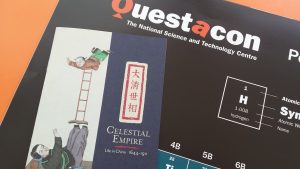In the aftermath of this week’s submarine decision, Australia needs to reassure a disappointed Japan of the strength of their partnership
The wash-up from this week’s decision by the Australian government to sign with a French provider of new submarines provides an opportunity to reflect on Australia’s developing triangulated relationship with China and Japan, and what it means for our Japanese friends.
According to the Sydney Morning Herald, the Japanese bid relied too much on strategic argument in a deal that ‘would bring two of the major democracies in Asia closer together at a time of rising instability caused by the emergence of China as a major power’. The submarine saga shows that Australia’s relationships with its wealthy North Asian neighbours are complicated and inextricably linked.
With free-trade agreements coming into effect with both Japan and China in January and December respectively, 2015 was a watershed year for Australia’s relationships. Bilateral arrangements were always significant given that the Trans-Pacific Partnership (TPP) did not include countries such as China, and are even more important for Australia now that adoption of the regional TPP has stalled.
Built evidence reflecting the two relationships is on display in Canberra’s Parliamentary Triangle.

The National Science and Technology Centre (Questacon) stands on one side of a wide boulevard. Questacon was built with the aid of Japanese government and business donations in the late 1980s, reflecting Australia’s long-standing economic and social ties with Japan. The Department of Foreign Affairs and Trade describes Japan as Australia’s closest and most mature partnership in Asia, which ‘is fundamentally important to both countries’ strategic and economic interests’. Japan remains Australia’s second most important trading partner.
On the other side of the boulevard, the National Library is hosting the ‘Celestial Empire: Life in China 1644–1911’ exhibition, which includes some items from the National Library of China (Beijing) on display outside of China for the first time. According to the Chairman of the Library’s Council, the exhibition ‘provides all Australians with an opportunity to expand our understanding of the history of a great nation and close neighbour’. DFAT also refers to the growing consultation mechanisms that Australia and China have established to advance cooperation and manage differences. Yet China overtook Japan to become Australia’s most important trading partner almost a decade ago.
The continuing difference in the depth of the relationships is reflected in the Pew Research Centre’s Global Attitudes and Trends Survey from 2015. The survey suggests that Australians still view Japan more favourably than China (80% to 57% respectively). These findings for Australia reflect general perceptions of Japan and China held by the public in all Asia–Pacific (APAC) countries, however. The Pew Survey found that 71 per cent of people in APAC viewed Japan favourably and 57 per cent viewed China favourably.
Australia’s dilemma
Japan’s understandable disappointment at failing to secure the submarine contract and a potential lack of affinity with China demonstrated by the results from Australia in the Pew Survey are not defining features of Australia’s relationships with these countries. The dilemma for Australia does not reside in its bilateral relationships with China and Japan. Rather, it lies in the relationships between China and Japan, and potentially between China or Japan and the United States.
The Pew Survey shows only 9 per cent of Japanese have a favourable view of China and only 12 per cent of Chinese have a favourable view of Japan.
The submarine bid was a manifestation of Japan’s anxiety about China: it is looking for deeper security partnerships
The results from Japan’s 2015 Cabinet Office’s Public Opinion Survey on the Self-Defence Force and Defence Issues also reflect Japan’s mistrust of China, which has increased over the three years since the survey was last carried out. Over 80 per cent of respondents in 2015 believed that it was in Japan’s interests to develop defence cooperation and exchange ties with countries other than the United States, but only 40.3 per cent thought that it was in Japan’s interests to do so with China. Importantly, the figure for 2015 was more than a 20 point drop from the 2012 survey’s 61.7 per cent of respondents who thought these relationships with China were in Japan’s interests.
Japan’s anxiety
Conversely, interest in Australia as a strategic partner increased in Japan according to the survey. Over a quarter of Japanese respondents thought that Japan should seek greater defence cooperation and exchange with Australia in 2015, up from 17.2 per cent in 2012. The submarine bid was a manifestation of Japan’s anxiety about China: it is looking for deeper security partnerships.
Australia is not the only country facing opportunities and dilemmas as a result of potential tension between China and Japan. South Korea and Thailand, for example, also have important relationships with both China and Japan. The trick for Australia and these countries is balancing, supporting and influencing where and if we can.
In the aftermath of the submarine decision, we need to reach out to our Japanese friends and assure them that Australia’s ‘closest and most mature’ partnership in Asia remains strong.
Featured image
The Collins-class submarine HMAS Rankin. The SEA 1000 project will replace the six Collins-class boats.

